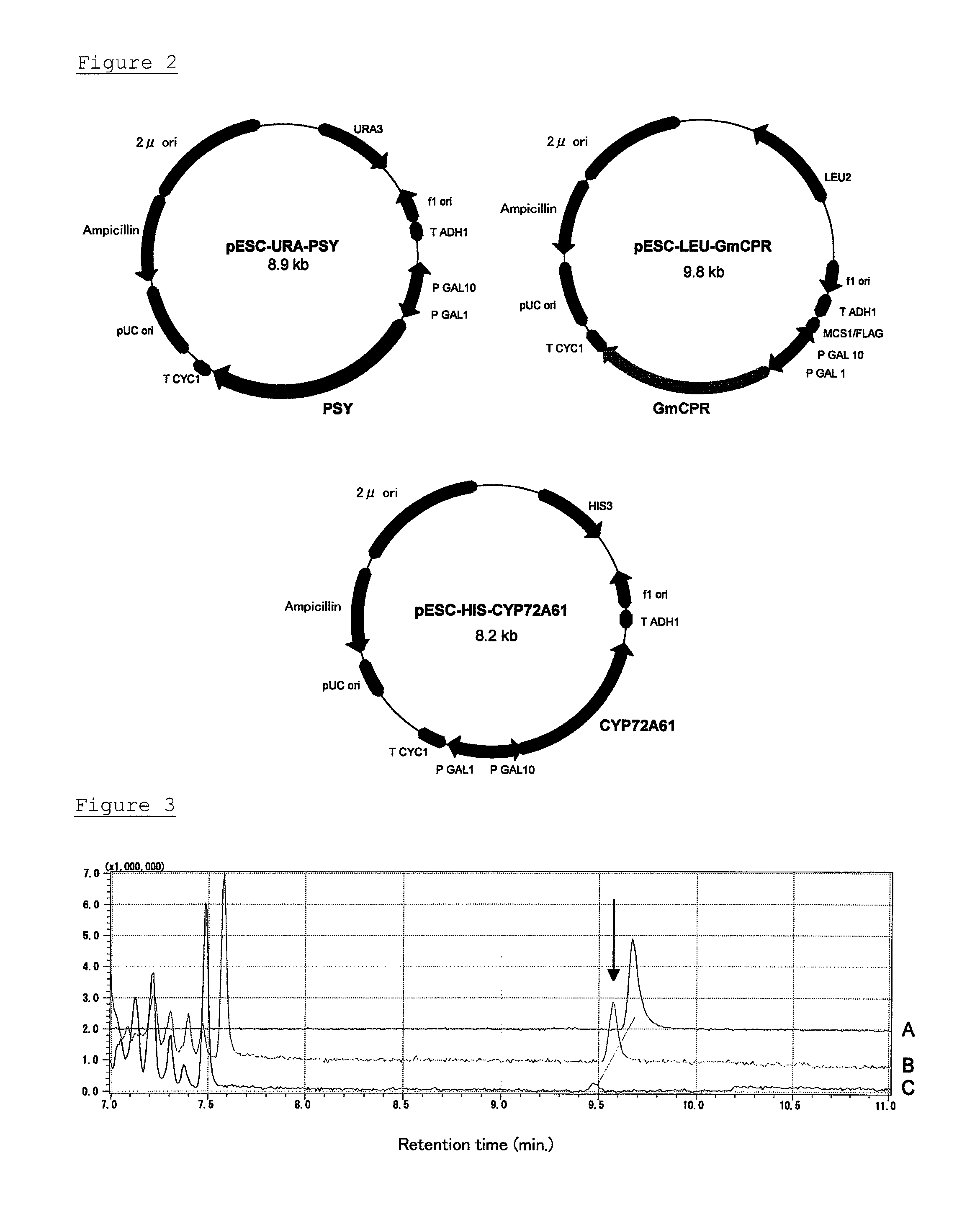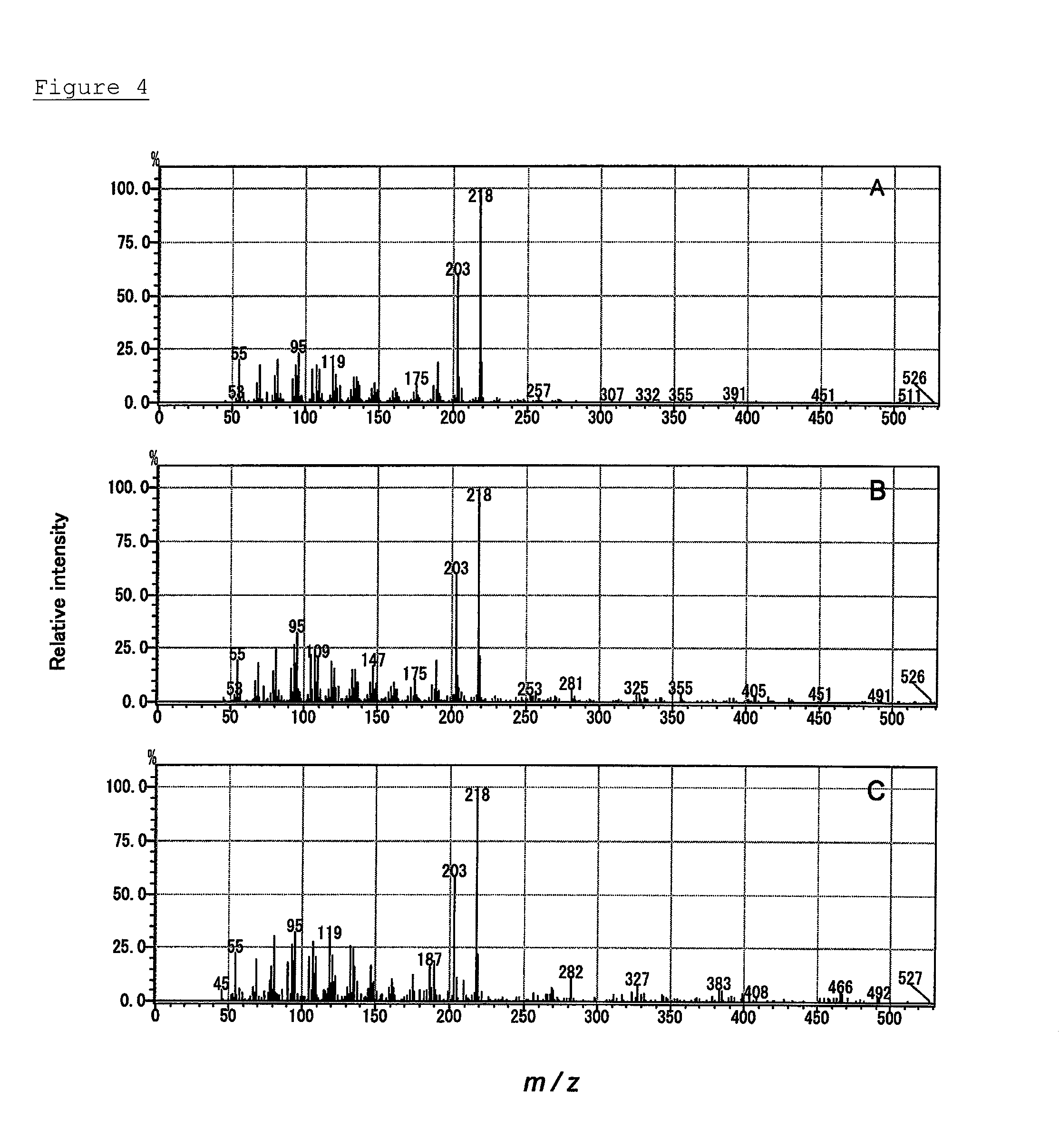C-22 hydroxylase
- Summary
- Abstract
- Description
- Claims
- Application Information
AI Technical Summary
Benefits of technology
Problems solved by technology
Method used
Image
Examples
example 1
Preparation of cDNAs from Soybean Seeds
[0101]Soybean (Glycine max) seeds (Aodaizu, purchased from Toraya Sangyou Co., Ltd.) were placed on moist absorbent cotton, and germinated at 25° C. under dark conditions for 5 days. Soybean sprouts (5.3 g) were collected, frozen in liquid nitrogen, and homogenized with a mortar and pestle. The resulting homogenate was suspended in 4.5 mL of 1 mol / L Tris-HCl buffer (pH 9.0). To this suspension, 5 mL of phenol / chloroform / isoamyl alcohol (25:24:1) solution [This mixed solution was saturated by adding 1 mol / L Tris-HCl buffer (pH 9.0) thereto. Hereinafter referred to as PCI] and 0.5 mL of 10% SDS aqueous solution were added, and well mixed on ice. After 1 mL of aliquots were taken from this mixture, these aliquots were centrifuged at 15000 rpm for 5 minutes at 4° C. to collect their upper layers. After 400 μL of PCI was added to each upper layer and well mixed, the upper layers were collected under the same conditions. After these upper layers were...
example 2
Determination of Full Sequence of CYP72A61
[0103]Soybean CYP72A61 on the soybean EST database (http: / / compbio.dfci.harvard.edu / tgi / plant.html) is a partial-length TC (Tentative Consensus) sequence TC204312 lacking approximately 150 amino acid residues at the N-terminus. This sequence data is transferred to TC343128.
[0104]The partial-length TC sequence TC204312 showed 83% homology to CYP72A61 (MtCYP72A61: Accession No. DQ335793) of Medicago truncatula (Leguminosae) on the GenBank database.
[0105]Primers were designed based on the MtCYP72A61 sequence to determine the upstream sequence of TC204312. The MtCYP72A61 sequence was compared to CYP72A5 (ABCYP72A5) of Arabidopsis thaliana (Brassicaceae) with 49% homology to MtCYP72A61, to find a sequence including conserved tryptophan located at about 50 bp from the N-terminus. Because the codon for tryptophan is one, a sense primer (Mt72A61-S) was designed based on the partial MtCYP72A61 nucleotide sequence corresponding to this portion. Furthe...
example 3
Cloning of NADPH-Cytochrome P450 Reductase (GmCPR) Gene from Soybean
[0109]In accordance with the report of Siminszky et al. (B. Siminszky et al., Pest. Biochem. Physiol. (2003) 77, 35-43), the sequence information of soybean (Glycine max) GmCPR (Accession No. AY170374) was obtained from the GenBank database. Based on the information, an N-terminal primer (GMR-BamHI-S) including the BamHI site added to the upstream of the initiation codon and a C-terminal primer (GMR-SalI-A) including the SalI site added to the downstream of the stop codon were designed, and a fragment was amplified by PCR using the soybean cDNA template for PCR prepared in Example 1. As a result, it was confirmed by electrophoresis that the desired fragment of approximately 2 kbp was amplified.
GMR-BamHI-S:(SEQ ID NO: 11)5′-gtt tgt gga tcc acc atg get tcg aat tcc-3′(The BamHI recognition site is underlined.)GMR-SalI-A:(SEQ ID NO: 12)5′-taa tca gtc gac tta cca gac atc tct aag-3′(The SalI recognition site is underlined...
PUM
| Property | Measurement | Unit |
|---|---|---|
| Fraction | aaaaa | aaaaa |
| Cell angle | aaaaa | aaaaa |
Abstract
Description
Claims
Application Information
 Login to view more
Login to view more - R&D Engineer
- R&D Manager
- IP Professional
- Industry Leading Data Capabilities
- Powerful AI technology
- Patent DNA Extraction
Browse by: Latest US Patents, China's latest patents, Technical Efficacy Thesaurus, Application Domain, Technology Topic.
© 2024 PatSnap. All rights reserved.Legal|Privacy policy|Modern Slavery Act Transparency Statement|Sitemap



